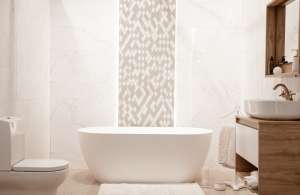Designing a home today goes far beyond choosing color palettes and arranging furniture. With increasing environmental concerns and shifting consumer values, sustainability has become a cornerstone of modern living. Homeowners and designers alike are now looking for ways to reduce environmental impact without compromising on style or functionality. One critical factor in this transformation is the selection of materials. From flooring to finishes, the materials we use shape not only the aesthetics of our homes but also their carbon footprint. For those navigating the world of Midland interior design, understanding eco-friendly options is key to building homes that are both beautiful and responsible.
Why Material Choices Matter More Than Ever
The construction and design industries account for a significant share of global energy consumption and greenhouse gas emissions. According to the International Energy Agency, buildings are responsible for nearly 40% of global carbon dioxide emissions. Much of this is tied to the extraction, processing, and transportation of materials used in construction and decor.
Sustainable material choices help mitigate these impacts. Materials that are renewable, recycled, or responsibly sourced can lower a home's carbon footprint, promote healthier indoor air quality, and reduce waste sent to landfills. These decisions also resonate with a growing number of homeowners who prioritize environmental stewardship.
Natural and Renewable Materials in Design
One of the easiest ways to design with sustainability in mind is to lean into materials that occur naturally and replenish themselves quickly. These include options that require minimal processing and are biodegradable at the end of their life cycle.
Bamboo: Fast-Growing and Versatile
Bamboo has surged in popularity thanks to its durability and incredibly fast growth rate. It can be harvested in three to five years, making it far more sustainable than traditional hardwoods that can take decades to mature. Bamboo is ideal for flooring, cabinetry, and even textiles.
Cork: Comfortable and Renewable
Harvested from the bark of cork oak trees without harming the tree itself, cork is a naturally renewable resource. Its soft, cushiony feel makes it ideal for flooring in living spaces or bedrooms. Additionally, cork is antimicrobial and resistant to mold, offering health benefits alongside sustainability.
Reclaimed Wood: Timeless and Responsible
Using reclaimed wood salvaged from old buildings, barns, or industrial sites not only adds character to a home but also keeps useful material out of landfills. Reclaimed wood can be used for flooring, accent walls, furniture, or beams, and its patina adds a sense of warmth and history that new wood can't replicate.
Recycled and Repurposed Materials
Choosing recycled or upcycled materials is another excellent way to reduce a home's environmental impact. These materials minimize waste and often require less energy to manufacture than their virgin counterparts.
Recycled Glass: A Touch of Sparkle
Recycled glass is often melted down and repurposed into countertops, tiles, or decorative surfaces. The result is a product that is both stylish and unique, often shimmering with a variety of colors. It also performs well in kitchens and bathrooms, being both durable and easy to clean.
Recycled Metal: Industrial and Sustainable
Metals like aluminum, copper, and steel can be recycled repeatedly without degrading their quality. Using recycled metal in home design—whether for roofing, railings, or fixtures—is a smart, long-lasting option that contributes to circular economies.
Upcycled Fabrics: Giving Textiles New Life
Textiles are a major contributor to landfill waste. Choosing upcycled fabrics for upholstery, curtains, and pillows reduces this impact. Some designers even use scraps of denim, wool, or silk to create one-of-a-kind furnishings that are as sustainable as they are stylish.
Low-Impact Finishes and Paints
Once the primary building materials are chosen, finishes and surface treatments are the next step. Unfortunately, many conventional paints, stains, and sealants contain volatile organic compounds (VOCs) that off-gas into indoor air.
VOC-Free Paints: Cleaner Indoor Air
Low-VOC or zero-VOC paints significantly reduce air pollution inside the home. These are available in a wide range of colors and finishes, making it easy to prioritize both health and aesthetics. Some brands also use natural pigments and sustainable packaging.
Natural Oils and Waxes: Safe and Effective
For finishing wood furniture or floors, plant-based oils like linseed or tung oil offer a non-toxic alternative to polyurethane. These natural finishes enhance the wood grain while providing a durable protective layer.
Lime Plaster: A Breathable Wall Finish
Used for centuries in traditional construction, lime plaster is making a comeback in modern homes. It is naturally antimicrobial, resistant to mold, and allows walls to "breathe," helping regulate humidity indoors.
Insulation and Energy Efficiency
Insulation is another area where sustainable choices can have a big impact. Poor insulation leads to energy waste, but certain materials offer eco-friendly solutions without sacrificing performance.
Sheep's Wool: Naturally Efficient
Sheep's wool is renewable, biodegradable, and highly effective as an insulator. It can absorb and release moisture without losing thermal performance, making it ideal for managing humidity and improving indoor comfort.
Cellulose Insulation: Made from Recycled Paper
One of the most sustainable insulation materials, cellulose is made from post-consumer recycled paper. It's treated with non-toxic fire retardants and performs just as well as fiberglass insulation.
Rigid Foam Alternatives
While traditional foam insulation is petroleum-based, newer bio-based foams made from materials like soybeans offer a more sustainable option. These are particularly useful for sealing gaps and insulating difficult spaces.
Looking Ahead: Smart, Sustainable Design Choices
The future of interior design is undoubtedly green. Beyond just material choices, sustainable design also encompasses efficient use of space, passive solar heating and cooling, and smart home technology that minimizes energy use.
Designers and homeowners who want to embrace sustainability should take a holistic view: What is the lifecycle of each material? Where does it come from, and where will it go when its time in the home is done? Making thoughtful decisions now can lead to healthier homes, lower environmental impact, and a greater sense of purpose in how we live.
By choosing responsibly sourced and low-impact materials, modern homes can be transformed into examples of environmental consciousness without sacrificing beauty or comfort. Whether you're renovating a room or building from scratch, integrating sustainable materials is an investment in the future—for both your home and the planet.






